7 Things You Need to Know to Start Windsurfing
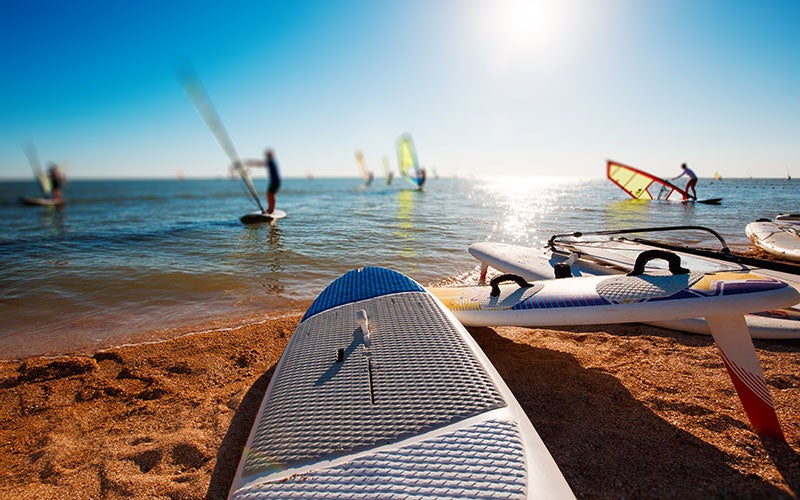 @Maximkostenko
@Maximkostenko
There’s no experience quite like riding the waves with the wind at your back. In fact, that’s probably why windsurfing is one of the most popular water activities in the world. But you can’t just hop on a board and expect to fly. Learning the right techniques is essential to ensuring your experience is smooth sailing. Keep reading to find out everything you need to know to start windsurfing ASAP.
Windsurfing Requirements
Windsurfing is among the most demanding water activities because you have to be able to control the ride while maintaining balance on your board. When the wind is especially gusty or the tide is rougher than usual, this isn’t always the easiest feat.
Because most of the moves involve active use of your back muscles, this sport isn’t necessarily the best for anyone with back problems. Knowing how to swim is also a must.
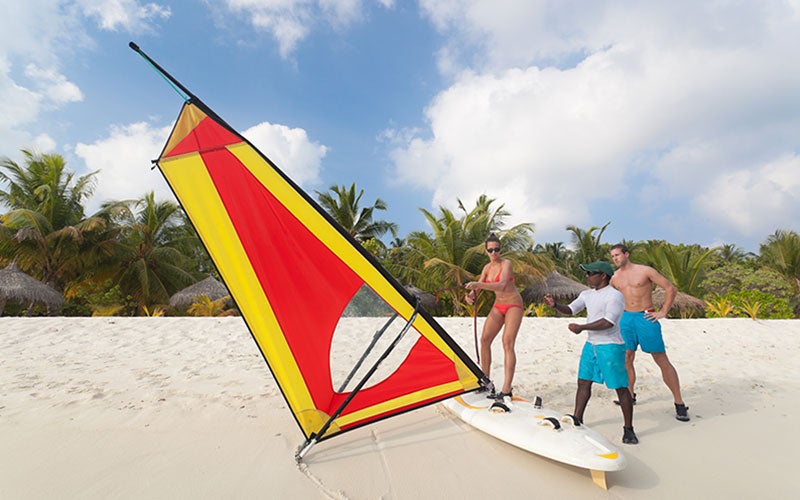
Our tip: To prepare yourself for your first windsurfing lesson, incorporate balance training and back strengthening exercises into your fitness routine.
Windsurfing vocabulary: The main terms to know
All physical activities have their own jargon. Take note of the most basic windsurfing terms so you always know what your instructor is talking about.
- Bear away: turning the board away from the wind.
- Rig: all the gear on the sail
- Front: the front end of the surfboard
- Port: riding to the left
- Port tack: the sail receives the wind from the left side
- Beach start: starting from shallow water
- Sheeting in: to pull the back of the sail towards you
- Rail: the edge of the board
- Leech: the back end of the sail
- Gybe/jibe: to turn away from the wind
- Tacking: turning toward the wind
- Mast extension: to stretch the sail along the mast
- Rigging: to set up and mount the sailing equipment
- Harness: a belt-like accessory used to attach to the boom
- Leeward: side sheltered from the wind
- Windward: side exposed to the wind
- Head up: the practice of getting closer to the direction of the wind
- Mast: a tube attached to the board that holds the sail in place
- Knots: unit of measurement of wind speed
- Offshore: The wind is traveling from land to sea
- Onshore: The wind is traveling from the sea to the land
- Mast foot: set of parts between the float and the mast
- Tail: back of the board
- Horizontal tide: The wind is parallel to the shore
- Vertical tide: The tide direction is perpendicular to the wind
- Starboard: sailing to the right
- Starboard tack: receiving wind from the right
- Transitions: alternating strokes on port and starboard tack to move against the wind
- Waterstart: to get back on the board in deep water
- Boom: the handlebars of the windsurfer
The Best Sail for Windsurfing
Windsurfing sails come in a variety of sizes and shapes that are uniquely suited to different skill levels. Here are the three main categories.
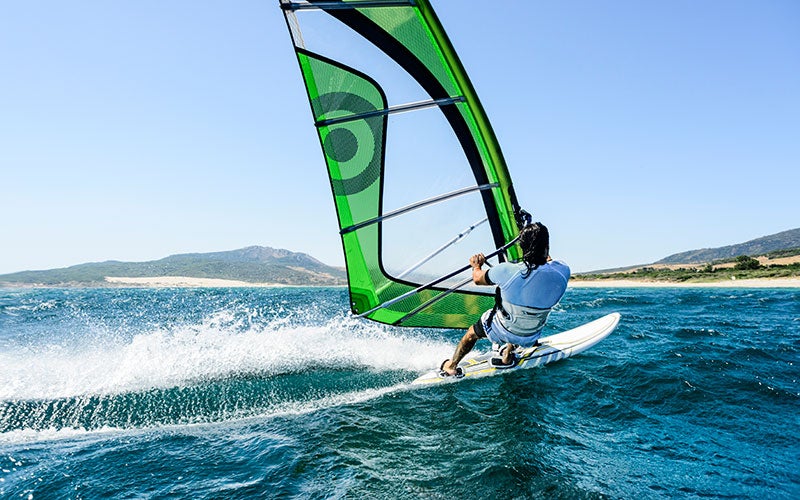
- Wave sails: These sails are very strong and can be used for surfing any kind of water.
- Freestyle sails: These sails are designed for gliding over water quickly. Freestyle sails are used by professionals and beginners alike.
- Slalom sails: These are particularly light and maneuverable, which makes them ideal for doing tricks on the water.
Our tip: Start with a smaller sail to get the hang of windsurfing.
The best windsurfing boards
Aside from the sail, the board is another essential part of the windsurfing equipment you’ll need. There are several options to choose from.
- Freeride board: These boards are best for beginners who are just starting to learn how to ride on flat water. Freeride boards are wide and they glide quickly.
- Waveboard: Wave boards are designed for advanced riders who want to glide and jump on the water.
- Race board: Race boards allow you to reach high speeds on the water. They are less suited to tricks and maneuvers.
- Freestyle board: Freestyle boards are uniquely designed for doing tricks and intricate maneuvers, but they don’t go very fast.
- Freestyle wave board: These are hybrid boards with which you can both do tricks and ride quickly.
Directions in windsurfing
The directions in which you turn during windsurfing are all known by different names.
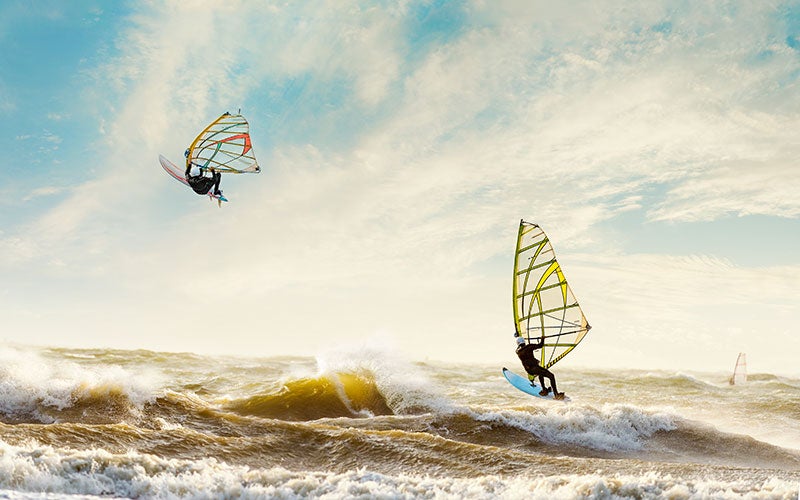
- Across wind: the board moves at 90 degrees to the wind direction.
- Beam reach: the wind hits the surfboard diagonally at 90 degrees.
- Downwind: The wind hits the board diagonally from behind when sailing downwind. This is the fastest course and it will allow you to cover the greatest distance.
- Tailwind: This is when you’re sailing with the wind directly behind you. It’s the slowest course in windsurfing.
The wind is everything in windsurfing. The more you have, the better you’ll do. However, beginners will be better off practicing with a light breeze so that they have time to get used to their gear and equipment.
Rules to Follow on the Water
Windsurfing is exciting but it can also be dangerous. That’s because your skills aren’t the only thing that determines how well you do. The wind and water conditions can change at any moment and put you at risk if you don’t know what you’re doing. In general, be cautious and plan ahead for your journey on the open water. Beginners in particular should always windsurf with an instructor to stay safe.
Other useful tips: Don’t windsurf at night, avoid obstacles such as rocks, and watch out for other surfers, swimmers, and kayakers.
Here are some of the most important “traffic rules” to follow on the water.
In windsurfing, the person who’s on the side that’s most exposed to the wind always has the right of way.
If two surfers come towards each other, the rule is “port tack before starboard tack”. That means the surfer who has their sail on the left side of the board has the right of way. It’s also important to remember that the right hand has priority and will be closer to the mast than the left hand in certain positions.
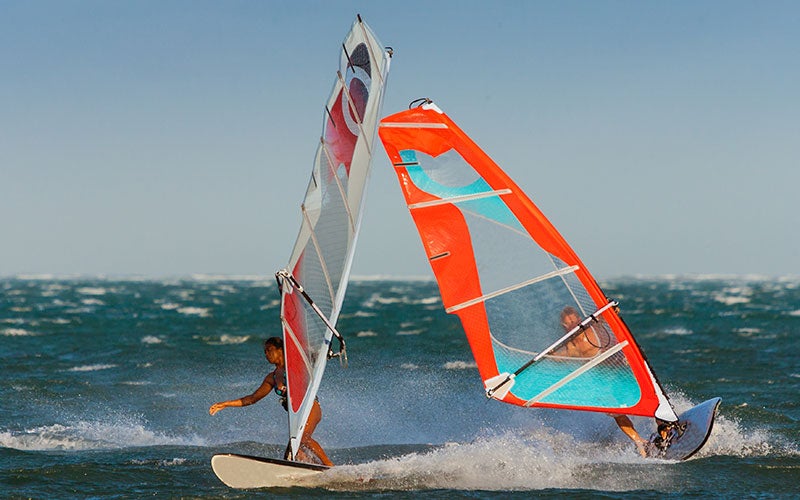
When overtaking another surfer, you must keep a distance of at least one mast length and pass the person in front of you in a large arc.
Alternatives to Windsurfing
Windsurfing depends entirely on the wind strength. If you find yourself getting frustrated when the weather isn’t suitable, familiarize yourself with other water activities to keep yourself busy in the off-time.
Practicing other water activities can also teach you techniques that you might not have learned from windsurfing alone. You may even find that you prefer an alternative altogether.
The most popular water sports are…
- Stand-Up Paddle Boarding: This is a sport in which you tackle the waves by standing on a large surfboard. All you need to do it is a board, a paddle, and a harness, though a lifejacket and other protective equipment can be beneficial.
- Kitesurfing: Kitesurfing is a lot like windsurfing in that you need strong winds rather than waves. Kitesurfing boards are much smaller and resemble snowboards, and instead of a sail, you’ll be pulled by a large kite.
- Wakeboarding: You can wakeboard no matter the wind and water condition. Along with a board, you’ll need a motorboat to pull you along.
Other sports that you might enjoy are jet skiing, scuba diving, snorkeling, kayaking, water skiing, and surfing.
Windsurfing: Our Conclusion
- Anyone with a healthy back and good swimming skills can windsurf.
- High winds are ideal for windsurfing. Start by training in low wind with the right windsurfing equipment.
- The wind determines the direction in which you surf. This is also known as the course.
- To practice windsurfing, you need a board, a sail with a mast, a double boom and a harness. There are different versions of windsurfing with different requirements.
- The most important rules on the water are to never surf at night or alone, watch out for obstacles, and respect the right of way.
- Popular alternatives to windsurfing are paddleboarding, kitesurfing, and wakeboarding, among others.
Sources for this article
We at foodspring use only high-quality sources, including peer-reviewed studies, to support the facts within our articles. Read our editorial policy to learn more about how we fact-check and keep our content accurate, reliable, and trustworthy.
































